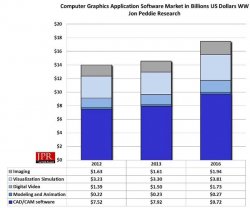But you're still using an arbitrary "1 hour" improvement to suit your argument. That 1 hour could easily be 4, or 5 hours, or even the 30 I mentioned in my previous comment. Sure, if you're just rendering overnight and you only see a 1 hour improvement, that's negligible. I'm not sure what you work on, but all of my renders are different based on the complexity of my projects. I'm not setting up the same thing every night where the processing time is easily predictable. I could set something to go overnight and see what used to be a 16 hour get knocked down to 12. So I could feasibly set that render up at 8pm the night before and be ready to get back to work again at 8am. Whereas I'd be waiting until noon previously. But this hypothetical really only scratches the surface on what a gain like that could to for productivity.
yeah, i'm definitely speaking loosely/arbitrarily with a lot of these numbers as there's an underlying tone which is more of my main point.. that being dual gpu - 1 cpu systems vs continuing to try to add more and more cpu to the computer..
the latter is more of a spec bump thing which requires me to spend a lot more money on nominal gains.. (just using virtualRain's poll, look how many people are buying a 12core nmp.. 1 person

...i'm sure everyone else in that poll wouldn't mind a 12 core but it's beyond their mean$.. )
whereas i can spent a lot less money on dual gpu and potentially see 20x or more speed increase in my renders.. speed increases that will actually change/benefit the way i work instead of what happens with more minor jumps in speed.
i guess what it comes down to is that i'm saying i really don't care if the nmp is single socket cpu.. i, along with the vast majority of other buyers, simply can't afford/justify much beyond an 8core system regardless of whether or not we want them..
i'm pretty sure apple knows that too which is why they did away with the dual sockets.. along with the fact that the next logical step in that type of development is a quad socket.. it's just way too expensive.. we can argue about it all we like but i honestly believe only a minuscule portion of buyers will even consider anything beyond 12core.. much less actually pay for it.
especially when considering the potential for meaningful speed increases in parallel processing is in the gpus.. cheap cores with considerable performance increase has won out over expensive cores with less beneficial improvements.. it just seems like we've reached the tipping point as far as multicore systems go.. it would be different if cpu prices were dropping over the years which could put ,say, 24core systems in the hands of many more people but that just doesn't appear to be happening.. that's why i call it a dead end street.. there's no future in that type of design (imo)
----------
oh.. and i guess it would also help to realize my main rendering program is already written in openCL (iteration #1 and more improvements in the pipeline) so i'm already seeing some of these types of gains i'm speaking of in my own work.. even with the 5770 which is currently in my desktop.
i understand it's a much different set of cards for someone whose current apps are reliant on cpu alone for performance increase.


